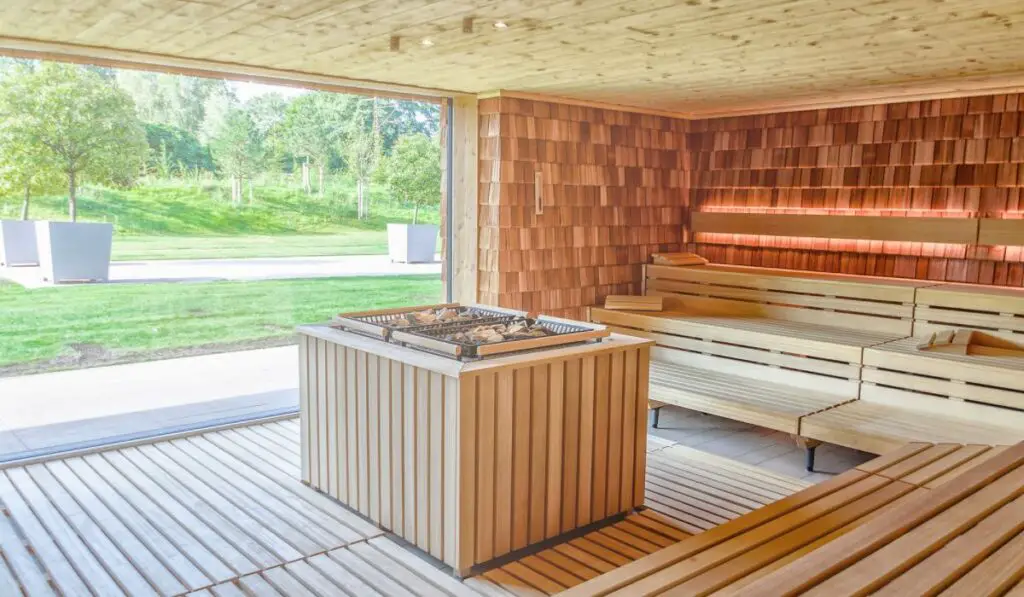When it comes to sweating out the toxins, you might be curious which is better: a sauna or sanarium? These terms may seem interchangeable, but you do get a different experience from each system. They also operate in slightly different ways.
Saunas are better for individuals who prefer dry heat over humidity. Sanariums offer a slightly cooler and significantly more humid experience, however, in spite of their differences, the health benefits are similar. With that said, it comes down to personal preference at the end of the day.
If you consider your tolerance for heat and your preference for humidity, you can gauge which is better for you. This is really the only factor in deciding which one is better. But, let’s take a deeper dive into what sanariums are and what makes them different from saunas.
What is a Sanarium?

A sanarium is fairly similar to a sauna in appearance. Both are usually smaller rooms with plenty of wood seating and usually a device somewhere in the room that regulates the heat as well as a hygrometer (on Amazon) to measure the temperature and humidity. That description can fit many types of hot rooms.
There are a variety of heat therapy rooms you might encounter including warm air baths, aromatherapy baths, soft steam baths, tropical baths, as well as steam rooms. What separates these rooms are how hot and how humid they are.
To put sanariums on this spectrum would place them between a sauna and a steam room. This means you can expect a slightly lower operating temperature of around 86°F to 104°F. When it comes to humidity sanariums, usually keep a steady 50% humidity throughout the session.
What are the Different Health Benefits of Saunas and Sanariums?
When it comes to health benefits, you are going to be getting a similar experience in each. If you think about the idea of a sauna or sanarium, you get a similar answer: sweat. Both rooms are great at getting your body heated up and producing sweat. Here are some benefits of both saunas and sanariums:
- Improved circulation — anything that increases your body temperature is going to pump your heart. Consequently, this will help increase your circulation.
- Lower blood pressure — When used regularly, both saunas and sanariums can help with blood pressure and overall cardiovascular health.
- Stress relief — Both are a great way to destress and relax.
- Stronger immune system — Heat therapy can help boost your immune system by pushing your body to produce a heat shock protein. This happens just above body temperature as it is part of your body’s natural defense system.
While a sanarium operates at slightly lower temperatures than a sauna, it is more than enough to bring up your body temperature. When your body temperature increases, you sweat and start to experience the health benefits.
One benefit that a dry heat sauna can’t provide is sinus relief. If you are someone who suffers from chronic allergies or other respiratory issues, the steam can help open your nasal passages. This can be a benefit for anyone looking for some nasal relief. This slightly separates sanariums from saunas. But there is another difference in the way they are used.
How are Sanariums Used Differently than Saunas or Steam Rooms?

As you may have gathered, sanariums are basically lower temp saunas with humidity. While this may seem like a trivial difference for some, it can be preferable for others. If the traditional heat of a dry sauna is too aggressive, the milder environment of a sanarium might feel more pleasant – you could also try a sauna blanket like the HigherDOSE Sauna Blanket V3.
Additionally, the heat of a traditional sauna limits the amount of time you can spend in a session. Most sauna users will spend at most 20 minutes sweating it out before taking a break. If you like to spend a bit more time in the heat, a sanarium gives you the opportunity.
As we explored earlier, sanariums are also great for people with respiratory issues. The humidity helps open up the sinuses and is perfect for people with sore throats or allergies. A sauna can also take a lot out of you. All that heat takes its toll. Sanariums are great for those who don’t want to feel like they just did a workout.
Can You Build Your Own Sanarium?
If you want to build your sanarium, you might have your work cut out for you. First of all, you are going to have to decide on a kit of a complete DIY setup. While most kits offered are sauna-specific, some slight alterations, and you can easily make it into a sanarium.
In fact, this is the case for most builds. What makes the difference is not so much equipment but how you operate the unit. If you opt for more humidity and less heat, boom, you’ve got a sanarium. You could even customize your build to cater to both sauna and sanarium sessions.
There is going to be a lot of decision-making if you opt to build your own sanarium. First of which is location. Usually, a small room is all you need. You can even decide on building outside, but that might come with its own challenges.
Once you have your spot, you now need to decide which heating unit you will use. There are electric units and ones that operate on gas. You will also need to insulate the walls as well. Usually, some type of wood will be involved for a more traditional feel. Another factor will be adding humidity. But once you’ve made all the decisions you can have your own custom-designed sanarium at home.
Aromatherapy and Sanariums
Another great benefit of using a sanarium is the ability to disperse aromatherapy scents. While you can certainly participate in aromatherapy at any time, the humidity and heat from the sanarium help the scents get into the air.
Aromatherapy sometimes enhances the health benefits of a sanarium including things like stress relief, pain relief, allergies, as well as relief from cold and flu symptoms like a sore throat. You can certainly use aromatherapy oils in a regular sauna as well. Usually, you do this by placing a small dish with your desired scents near the heating device. This will help activate the oils and help them spread in the air.
What if You Want More Steam?
For many people, the allure of the sanarium is the humidity. The temperature certainly has a factor, but most sauna controls will allow you to lower down to almost any temperature you like. But if you are looking for more humidity, you may need to purchase a steam room instead of a sanarium.
Steam rooms operate at almost 100% humidity. These are best for those who really want to feel the heat. They do get some getting used to, but steam rooms are really popular in Europe, additionally, there are other types of saunas as well like infrared.
Wrapping Up
When it comes down to it, both sanariums and saunas provide a similar experience. What makes them different is how they operate. Sanariums are often used at lower temperatures and use a higher humidity level of 50%.
Looking at health and wellness and you see a similar list of benefits. As long as you are building body heat and sweating, you are getting the kinds of benefits that this type of heat therapy can involve. For people with respiratory issues or allergies, the humidity of a sanarium might be preferable. But, at the end of the day, which one is better comes down to personal choice.
